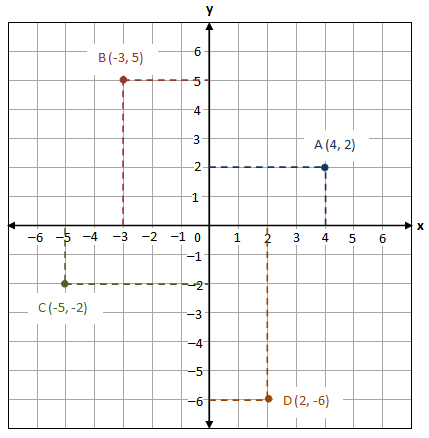The coordinate plane is a two-dimensional surface where we can plot points, lines, geometric shapes and curves. The coordinate plane is also called as Cartesian plane. It was invented by the French mathematician Rene Descartes in the 17th century.
The coordinate plane has two scales (number lines) perpendicular (at right angle) to each other.
The horizontal scale is called the x-axis. Like a number line, the values increase and are positive as we move to the right from the zero. The values are negative and decrease as we move to the left from zero.
The vertical scale is called the y-axis. The values on this axis are positive and increase as we go up from the zero. As we move down from zero, the values are negative and decreasing.
The set of x and y values are called ordered pair, also called as coordinate, represented as (x, y). The first value shows the distance from x-axis and the second value shows the distance from the y-axis.
The point where these two axes meet is called the origin, represented by ordered the pair (0, 0). All the distances along x and y axes are measured from the origin.
The two axes divide the coordinate plane into four areas called quadrants. The top right area is the first quadrant where both x and y values are positive. As we go around anti-clockwise, the top left area is the second quadrant where x coordinate is negative and y coordinate is positive. Below the second quadrant is the third quadrant which has both x and y values negative. Below the first quadrant and to the right of third quadrant is the fourth quadrant where x is positive and y is negative.
Example
On the coordinate plane below:
Coordinates of point A are (4, 2)
Coordinates of point B are (-3, 5)
Coordinates of point C are (-5, -2)
Coordinates of point D are (2, -6)




